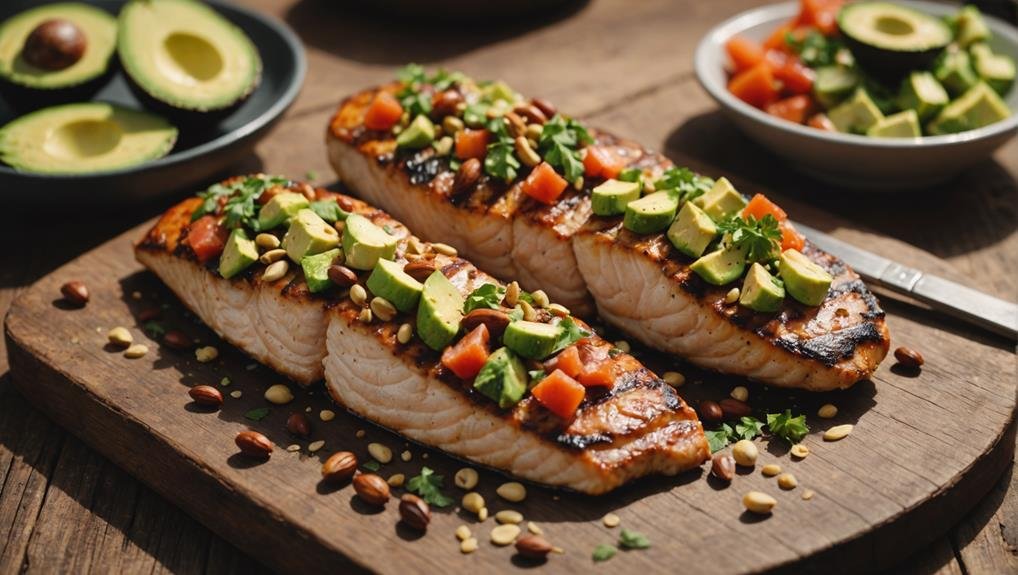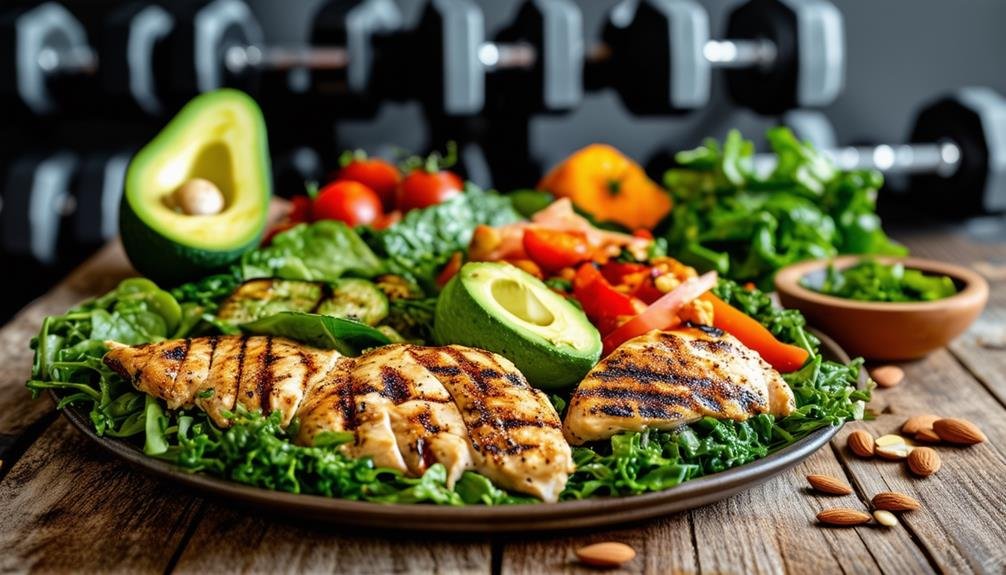To tailor your keto diet for muscle gain, modify your macronutrient distribution to consist of approximately 65% fat, 30% protein, and 5% carbohydrates.
It is advisable to consume protein at a rate of 0.7-1g per pound of body weight, focusing on high-quality protein sources such as lean meats, fish, and eggs to facilitate muscle repair.
Strategically time your meals around your workouts to maximize recovery, and consider consuming small amounts of carbohydrates prior to exercise for an energy boost.
Adjust your meal frequency to align with your energy needs and the intensity of your training.
Additionally, incorporating resistance training and considering supplements like creatine can further enhance muscle growth.
By implementing these strategies, you can optimize your keto diet for effective muscle gain.
Key Takeaways
To effectively customize your keto diet for muscle gain, follow these guidelines:
- Macronutrient Ratios: Aim for a daily intake of approximately 65% fats, 30% protein, and 5% carbohydrates, ensuring that total carbohydrate consumption remains below 50g to maintain ketosis.
- Leucine-Rich Proteins: Incorporate high-quality protein sources rich in leucine, such as whey protein, chicken, and eggs. This will support optimal muscle preservation and growth.
- Protein Distribution: Spread your protein intake across 3-4 meals each day, with each meal containing 25-35g of protein. Focus on timing your protein consumption around workout sessions for enhanced muscle recovery.
- Resistance Training: Engage in regular resistance training, prioritizing compound exercises that target all major muscle groups. Aim to train each muscle group at least twice a week for effective muscle development.
Understanding the Keto Diet
To effectively understand the keto diet, it's vital to recognize its significant shift in how the body obtains energy, prioritizing fats over carbohydrates. This approach drastically limits carbohydrate intake, typically to less than 50 grams per day. As a result, the body undergoes metabolic adaptation, transitioning to burning fat and generating ketones for energy, leading to a state known as ketosis. This metabolic state is crucial for enhancing fat-burning efficiency.
In the context of a ketogenic diet, the macronutrient distribution generally comprises around 70-75% fats, 20-25% protein, and a minimal 5-10% carbohydrates. While fat loss is often the primary focus of the keto diet, it's essential to ensure sufficient protein intake to promote muscle maintenance and growth, particularly when engaging in resistance training.
For those aiming to build muscle on a keto diet, monitoring daily caloric intake is critical. Even in ketosis, consuming enough calories is vital for fostering muscle growth. While protein needs can vary, it's advantageous to prioritize the quality and timing of protein sources to optimize results.
Transitioning into ketosis typically takes about 2-4 days, during which one may experience symptoms often referred to as the 'keto flu,' including fatigue and irritability. However, grasping the relationship between calorie intake, protein consumption, and dietary fat is essential for leveraging the keto diet effectively for muscle gain.
With a well-planned strategy, you can successfully pursue this distinctive dietary lifestyle.
Macronutrient Ratios for Muscle Growth
Balancing macronutrient ratios is essential for optimizing muscle growth while following a ketogenic diet. A recommended macronutrient ratio for this approach is approximately 65% fat, 30% protein, and 5% carbohydrates. This balance provides the necessary energy while promoting muscle protein synthesis. Aim for a protein intake of about 0.7-1 gram per pound of body weight to support muscle repair and growth. This protein level is also crucial for maintaining ketosis, allowing the body to use fat as its primary energy source.
To enhance muscle gain, maintain a caloric surplus of around 350-450 calories above your maintenance level, even within a low-carb framework. Keep daily carbohydrate intake below 50 grams to ensure your body remains in ketosis, optimizing fat utilization for energy.
Adjusting your macronutrient ratios based on personal energy levels and workout performance may be necessary, especially during the initial adaptation phase of the keto diet. Regularly monitoring your progress is important; if you experience fatigue or stagnation in muscle growth, consider adjusting your caloric surplus or protein intake.
Ultimately, developing an individualized macronutrient plan that aligns with your body weight and training needs can significantly improve your muscle growth while adhering to a ketogenic lifestyle. Staying informed about potential adjustments will contribute to better results on your fitness journey.
High-Quality Protein Sources

When customizing your keto diet, it's essential to focus on high-quality protein sources to promote muscle growth.
Prioritizing nutrient-dense options such as lean meats, eggs, and full-fat dairy is crucial, as they provide essential amino acids and healthy fats.
Additionally, incorporating leucine-rich proteins can enhance muscle preservation and improve overall performance.
Essential Protein Sources
Incorporating high-quality protein sources into your keto diet is vital for muscle repair and growth while maintaining ketosis. To support muscle gain and preservation, prioritize lean meats such as chicken, beef, and pork, which provide essential amino acids necessary for effective recovery.
Eggs and whole-fat dairy products—like Greek yogurt and cheese—are also excellent options, offering a complete amino acid profile crucial for protein synthesis.
Aim for protein to constitute about 15-20% of your total caloric intake, with a target intake of approximately 0.6-0.8 grams of protein per kilogram of body weight. This approach aids in muscle preservation without disrupting your ketogenic goals.
Be cautious to avoid lower-quality protein sources, such as grains and legumes, as they're typically higher in carbohydrates and can hinder your ability to maintain ketosis.
For enhanced results, include leucine-rich protein sources like whey protein, as leucine is key in stimulating muscle protein synthesis.
Leucine-Rich Options
Have you thought about how incorporating leucine-rich protein sources can maximize your muscle growth while adhering to a ketogenic diet?
Leucine is an essential amino acid that's pivotal for muscle protein synthesis. To enhance your muscle-building efforts on a keto plan, focus on integrating protein sources that are abundant in leucine. Here are some excellent options:
- Whey Protein: This protein powder boasts approximately 10g of leucine per 100g, making it one of the most effective choices for muscle development.
- Chicken Breast: A lean source of meat that provides around 1.8g of leucine per 100g, it's a fantastic option for those looking to increase their protein intake.
- Greek Yogurt: Offering roughly 3g of leucine in a 200g serving, it provides both protein and beneficial probiotics for digestive health.
- Eggs: Each large egg contains about 1.1g of leucine, making them a versatile and convenient addition to your diet.
By incorporating these leucine-rich protein sources into your meals, you can ensure that you achieve the necessary threshold for optimal muscle growth.
This approach not only promotes muscle preservation but also supports your overall fitness objectives while following a ketogenic diet.
Quality Over Quantity
To optimize muscle preservation and growth on a ketogenic diet, prioritize high-quality protein sources such as eggs, lean meats, and whole-fat dairy. These foods are abundant in essential amino acids, crucial for effective muscle protein synthesis. Aim for a protein intake of approximately 0.6-0.8 grams per kilogram of body weight to align with your muscle-building objectives while staying in ketosis.
Incorporating protein sources rich in leucine, like chicken, beef, and Greek yogurt, is essential, as leucine significantly stimulates muscle protein synthesis. These high-quality animal proteins play a critical role in preserving lean muscle mass, particularly during calorie deficits.
It's advisable to limit lower-quality protein sources, such as grains and legumes, which may disrupt ketosis and not provide the necessary muscle-building advantages.
To ensure a steady supply of amino acids for muscle recovery, include whole-food protein sources in every meal. This strategy will enhance your body's ability to repair and grow following workouts.
Meal Timing and Frequency
How does meal timing and frequency influence your success on a keto diet? Effectively structuring your meals can significantly boost muscle gain while keeping you in ketosis. Proper meal timing and frequency optimize protein intake and enhance muscle synthesis, leading to improved workout performance and sustained energy levels.
Here are key guidelines for effective meal timing and frequency on a keto diet:
- Distribute your protein throughout the day: Aim for 3-4 meals daily, each containing 25-35 grams of protein. This approach helps you achieve the leucine threshold necessary for muscle growth.
- Schedule meals around workouts: Consuming food close to your workout times can improve performance and accelerate recovery. For some, a small intake of targeted carbs before exercise may provide additional energy.
- Prioritize hydration: Regular hydration is crucial, especially on a keto diet. Ensuring proper electrolyte balance during meals can enhance metabolic functions and overall wellness.
- Tailor meal frequency to your needs: Pay attention to your energy levels and workout intensity. If you find yourself feeling fatigued, increasing meal frequency or adjusting your protein intake may better support your muscle-building objectives.
Training Strategies for Muscle Gain

To effectively build muscle on a ketogenic diet, focus on resistance training techniques.
Incorporate compound exercises and practice progressive overload to stimulate muscle growth.
Establishing a structured routine with adequate sets and repetitions is essential for achieving optimal results.
Resistance Training Techniques
Resistance training is essential for muscle development, and utilizing compound exercises such as squats and deadlifts can significantly enhance your results. These exercises work multiple muscle groups simultaneously, providing substantial strength training benefits.
To optimize your resistance training for muscle growth, consider implementing the following strategies:
- Prioritize compound exercises: Focus on movements like bench presses and pull-ups to engage a wider range of muscles.
- Adopt a structured training program: Implement full-body hypertrophy or upper/lower split routines to effectively target different muscle groups.
- Target a rep range of 6-15: This rep range is particularly effective for stimulating hypertrophy while allowing adequate recovery time between sessions.
- Emphasize recovery: Aim for 7-9 hours of quality sleep each night to facilitate muscle repair and enhance performance during workouts.
Progressive Overload Importance
Progressive overload is essential for unlocking your muscle growth potential by continually pushing your body to adapt and strengthen. To promote muscle gain, it's crucial to gradually increase the weights, frequency, or intensity of your strength training sessions.
Ideally, you should target each muscle group at least twice per week, emphasizing compound exercises such as squats, deadlifts, and bench presses. These movements efficiently engage multiple muscle groups, optimizing your results.
For optimal growth, aim for a repetition range of 6 to 15 reps per set. Select a weight that leads to muscle fatigue by the end of each set. To ensure you're effectively applying the principle of progressive overload, maintain workout logs to track your lifts, allowing you to make informed adjustments to weights and reps over time.
Additionally, introduce variations in your training regimen by changing exercises or modifying rest periods. It's also critical to monitor your protein and calorie intake, as these elements play a vital role in supporting muscle recovery and growth.
Supplements to Consider
When tailoring your keto diet, it's beneficial to consider specific supplements that can improve performance and support your health throughout this low-carb lifestyle. These supplements not only promote muscle mass development but also aid in workout efficiency and recovery. Here are four important options to contemplate:
- Creatine: A well-studied supplement, creatine enhances ATP production, which is crucial for high-intensity exercises. It boosts strength and muscle mass, making it particularly advantageous for individuals following a ketogenic diet.
- Branched-Chain Amino Acids (BCAAs): BCAAs are effective in reducing muscle soreness and improving recovery times. This supplement is especially beneficial during the initial adaptation phase of the ketogenic diet, when muscle performance may temporarily decrease due to dietary changes.
- MCT Oil (Medium-Chain Triglycerides): MCTs provide a rapid energy source by quickly converting to ketones, which helps maintain ketosis and can improve workout performance.
- Electrolyte Supplements: Maintaining balanced electrolyte levels is vital on a ketogenic diet. Supplements containing sodium, potassium, and magnesium can prevent imbalances that could lead to issues such as cramps or fatigue, particularly during the adaptation period.
Additionally, consider exogenous ketones to support elevated blood ketone levels. These can potentially enhance exercise performance and improve recovery while adhering to a ketogenic regimen.
Frequently Asked Questions
Can You Build Muscle While on a Keto Diet?
Yes, it is possible to build muscle while following a keto diet by ensuring adequate protein intake, allowing time for adaptation to ketosis, and focusing on strategic meal timing. It's essential to prioritize healthy fats, monitor your energy levels, and integrate effective recovery strategies to optimize workout performance and achieve your fitness objectives.
What Is the Keto Ratio for Muscle Gain?
The optimal keto ratio for muscle gain generally consists of 65-70% fat, 25-30% protein, and 5-10% carbohydrates. To maximize muscle growth, emphasize nutrient-dense foods, strategically time your meals, and maintain a positive energy balance. Additionally, ensure adequate protein intake and consider effective supplementation strategies to support your muscle gain goals.
What Should I Eat to Bulk up on Keto?
To support your muscle growth on a keto diet, consider meal prep as a vital strategy. Focus on incorporating high-protein snacks, healthy fats, and keto-approved supplements into your diet. Additionally, maintain proper hydration, practice portion control, and implement effective weightlifting techniques to optimize your muscle recovery.
Can a Bodybuilder Do a Keto Diet?
Yes, bodybuilders can effectively follow a keto diet. To support muscle preservation, prioritize high-quality protein sources. Implementing carb cycling can help maintain energy levels for intense workouts, while optimizing fat adaptation is essential for efficient fat utilization. Additionally, focusing on meal timing and incorporating the right supplements can further enhance workout performance and improve nutrient absorption during training.
Conclusion
To effectively customize your keto diet for muscle gain, it's essential to focus on high-quality protein sources, optimize macronutrient ratios, and time your meals strategically to enhance muscle growth.
Integrate efficient training techniques and consider the use of supplements if necessary, similar to how a chef fine-tunes ingredients for an ideal recipe.
With thorough planning and commitment, you can build strength while reaping the rewards of a low-carb lifestyle.
